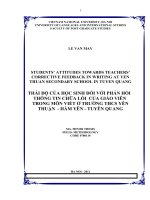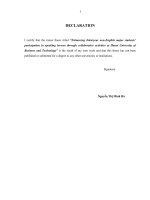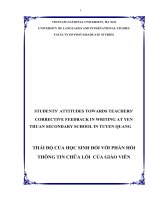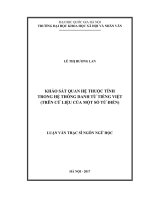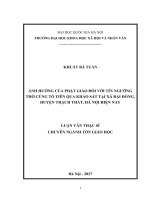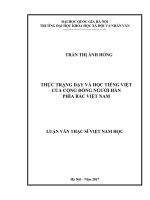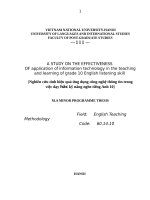LUAN VAN THAC SY TIENG ANH
Bạn đang xem bản rút gọn của tài liệu. Xem và tải ngay bản đầy đủ của tài liệu tại đây (1.2 MB, 65 trang )
VIETNAM NATIONAL UNIVERSITY, HA NOI
UNIVERSITY OF LANGUAGES AND INTERNATIONAL STUDIES
FACULTY OF POST-GRADUATE STUDIES
LE VAN MAY
STUDENTS’ ATTITUDES TOWARDS TEACHERS’
CORRECTIVE FEEDBACK IN WRITING AT YEN
THUAN SECONDARY SCHOOL IN TUYEN QUANG
THÁI ĐỘ CỦA HỌC SINH ĐỐI VỚI PHẢN HỒI
THÔNG TIN CHỮA LỖI CỦA GIÁO VIÊN
TRONG MÔN VIẾT Ở TRƯỜNG THCS YÊN
THUẬN - HÀM YÊN - TUYÊN QUANG
MA. MINOR THESIS
FIELD: METHODOLOGY
CODE 0780110
HA NOI - 2011
1
VIETNAM NATIONAL UNIVERSITY, HA NOI
UNIVERSITY OF LANGUAGES AND INTERNATIONAL STUDIES
FACULTY OF POST-GRADUATE STUDIES
LE VAN MAY
STUDENTS’ ATTITUDES TOWARDS TEACHERS’
CORRECTIVE FEEDBACK IN WRITING AT YEN
THUAN SECONDARY SCHOOL IN TUYEN QUANG
THÁI ĐỘ CỦA HỌC SINH ĐỐI VỚI PHẢN HỒI
THÔNG TIN CHỮA LỖI CỦA GIÁO VIÊN
TRONG MÔN VIẾT Ở TRƯỜNG THCS YÊN
THUẬN - HÀM YÊN - TUYÊN QUANG
MA. MINOR THESIS
FIELD: METHODOLOGY
CODE 0780110
HA NOI - 2011
2
CERTIFICATE OF ORIGINALITY OF PROJECT REPORT
I certify my authority of the Study Project Report submitted entitled
Students’ Attitudes towards Teachers’ Corrective Feedback in Writing
At Yen Thuan secondary school – Ham Yen - Tuyen Quang
in fulfillment of the requirements for the degree Master of Arts
Hanoi, may 2011
Le van may
ACKNOWLEDGEMENTS
3
First of all, I would like to express my deepest thanks to my superior Do
Xuan Khoi, M.A. for the support, guidance and valuable critical feedback. His
help, stimulating suggestion and encouragement helped me a lot right from
the beginning to the end of this study.
I would like acknowledge my sincere thanks to the headmaster, the teachers
of English Group and the students at Yen Thuan secondary school Ham Yen -
Tuyen Quang who helped me a lot and showed great willingness to take part
in my survey.
My special thanks also go to my lecturers, my friends, my classmates for
valuable comments and criticism, their interest and encouragement.
Last but not least, I want to express my deepest gratitude to my wife, my
parents and my children for their love, care, tolerance and encouragement.
4
ABSTRACT
Many language educators and researchers (e.g., Nunan; 1987; Horwitz,
1988; Schulz, 2001) claim that matching the expectations of teachers and
students is important for successful language learning. Accordingly, it is
beneficial for teachers to discover their students’ perceptions toward the
feedback they received. This study investigates the students’ attitudes towards
teachers’ corrective feedback at Yen Thuan secondary school Ham Yen-
Tuyen Quang. The participants included 4 teachers of English and 100
students from Grade 7 to 8. The data were collected from survey
questionnaires for students, the direct interview with four teachers and
teachers’ commentary on the students’ written work. The results show that
there is a slight mismatch between teachers’ beliefs and students’ preferences
for teacher corrective feedback regarding feedback types and forms, various
features of writing, and error correction techniques. Also, it is important for
teachers to be aware of the impact of their feedback practices on students’
expectations and attitudes. On this basis, the study recommends a number of
directions for teachers to help them improve their feedback practices more
effectively.
5
TABLE OF CONTENTS
Certification………………………………………………………………… i
Acknowledgements……………………………………………… ……… ii
Abstract………………………………………………………………….… iii
PART ONE - INTRODUCTION 8
1.1. Rationale of the study 8
1.2. Aims of the study 10
1.3. Research questions 10
1.4. Scope of the study 10
1.5. Methods of the study 11
1.6.Design of the study 11
PART TWO. DEVELOPMENT 12
CHAPTER 1: LITERATURE REVIEW 12
1.1.Theoretical backgrounds of feedback 13
1.1.1.Definitions of feedback 13
1.1.2. The importance of feedback in L2 writing 14
1.1.2.Types of feedback to students’ writing 15
1.1.2.1.Self-editing 16
1.1.2.2.Peer feedback 16
1.1.2.3. Teacher’s feedback 18
1.2.The focus of teacher feedback 19
1.2.1.Types of teacher feedback 19
1.2.1.1.Marginal versus end feedback 20
1.2.1.2.Positive versus negative feedback 20
1.2.1.3.Text – specific versus general feedback 21
1.2.1.4.Feedback focus on form versus on content 21
1.2.2.Forms of teacher feedback 22
1.2.3.Major issues in giving teacher’s feedback 23
2.1.Context of the study 25
2.1.1.The setting of the study 25
2.1.2.The writing program 26
2.1.2.1.Overview of the textbooks 26
2.1.2.2.The teaching of writing skill 27
2.2. The study 28
2.2.1.Methodology 28
2.2.1.1.The subjects 28
2.2.1.2.The instruments: 29
2.2.1.3. Data collection methods 30
2.2.2.Data analysis 30
2.2.2.1.Data analysis of classroom observation 30
2.2.2.2.Data analysis of direct interview between the researcher and four teachers 31
2.2.2.2.1.Teachers’ demographic information 31
2.2.2.2.2. Analysis of the interview 32
2.2.2.3.Observation of teacher commentary on the students’ drafts 35
2.2.2.4.Data analysis of student’s survey questionnaire 36
6
2.2.2.4.1.Students’ demographic information 36
2.2.2.4.2.Analysis of students’ survey questionnaire 36
2.2.3.Findings and discussion 43
CHAPTER THREE: RECOMMENDATION AND SUGGESTIONS 48
PART THREE. CONCLUSIONS 50
3.1. Summary 50
3.2. Limitations of the study and suggestions for further studies 51
References
Appendices
7
PART ONE - INTRODUCTION
1.1. Rationale of the study
Today English is considered one of the most important factors to the
trend of globalization in all fields of life over the world. Thus, English as
Second Language has been taught in many countries and the demand to use
English fluently as well as to acquire four basic skills is becoming essential
among all students. As a result, methodology has been studied for years to
find out the most effective ways of teaching and learning English.
In Vietnam, secondary school students have to acquire four skills of
English as reading, speaking, listening and writing when they study English.
Among them, writing is considered the most difficult skill. Clearly,
Vietnamese students are often much anxious about writing and afraid of
making errors in writing classrooms. Nevertheless, they need to be
encouraged to see it as a means of learning, rather than demonstrating
learning. In order to do this, students need to be provided with opportunities
to respond to constructive feedback on their work.
A review of the literature on writing reveals three major areas of
feedback as revision: peer feedback, self-editing and teachers’ comments as
feedback. Because of the importance of feedback, there have been a lot of
studies that focus on all aspects relating to feedback. As clear, concise
feedback matched to standards will promote students’ achievement, feedback
plays a very important role in the teaching of any language. Through
feedback, the writer learns where he or she has misled and confused the
reader by not supplying enough information, illogical organization, lack of
development ideas, or something simple like inappropriate word-choice or
tense. In other words, the writers have opportunities to identify their errors
and correct them to make better writing. Also, the use of teacher feedback in
writing classrooms has been generally supported in the literature review as a
8
potentially valuable aid for its social cognitive, affective and methodological
benefits ( Merlin, (1986), Radecki and Swales (1988), Hedge (2000), Ferris
and Roberts (2001)). They all believe that teacher feedback is very important
and has a great influence on the success of teaching and learning writing.
As a teacher of English at Yen Thuan secondary school, the researcher
is constantly searching for ways to help his students become more confident
and effective writers. During writing lessons, she finds that her students often
make a lot of errors that increase students’ anxiety in writing lesson. With a
view of language learning as a creative construction process, she shares an
agreement with Hedge (2000) in the view that error is an inevitable and
positive part of that process (p.15). Hedge also claimed that “learners progress
faster with meaningful language practice in a rich linguistic environment and
with an informed policy of error correction on the part of the teacher” (p.15).
This means teacher-response is an essential step in the writing process as he
stated “getting feedback from the teacher and from other students in the class
enables learners to test hypotheses and refine their developing knowledge of
the language system” (p.13). That is why the researcher focuses on teacher
corrective feedback, which she considers a complex troublesome, but
important issue in writing classrooms. To have a quick view on this aspect, an
observation on the writing lessons of four teachers of English in the
researcher’s school was conducted within a month. The result showed that all
the four teachers applied mostly teacher corrective feedback to respond to the
students’ writings. She wondered if the teachers’ present feedback matched
with students’ preferences and how students reacted to the feedback they
received.
All above encouraged the researcher to conduct a survey to explore
students’ attitudes towards teacher corrective feedback and recommend
9
teachers of English some suggested solutions to help their students gain more
achievement in writing skill.
1.2. Aims of the study.
This research is designed to explore students’ attitudes toward their
teachers’ corrective feedback at . It is expected to achieve the three primary
aims:
(i) to investigate the teacher feedback-giving practice in writing classes:
their responding methods, their feedback focus as well as the feedback types
and forms.
(ii) to investigate the students’ perceptions of the feedback they receive
and their recommendations for improving it.
(iii) to find out students’ preferences for teachers’ corrective feedback
as well as to propose some recommendations and suggestions for the teachers
to improve their practice in order to respond to the students writing more
effectively.
1.3. Research questions
In order to achieve the mentioned aims above, the following research
questions will be included in the study:
1. How do the teachers respond to the students’ writing?
2. What are the students’ opinions on the feedback they received?
3. What are EFL students’ preferences for teachers’ corrective feedback
techniques?
1.4. Scope of the study
Feedback in writing is such a broad topic that the researcher cannot
discuss all the aspects related. Therefore, within the framework of a minor
thesis, this study focuses only on the teacher corrective feedback in
10
responding to the students’ writing at Yen Thuan secondary school Significance
of the research
The research is carried out with the hope that the results of the study will
provide significant insights into both what teachers have actually done as they
respond and how the students react to these responses. This may lead to
suggestions for improving teacher feedback and helping the students to utilize
it more successfully in their writing revision.
1.5. Methods of the study
To realize the aims, the following methods for data collection were
employed in the study.
1.5.1. Data were collected by means of survey questionnaires for 100
students at Yen Thuan secondary school. The questionnaires
included closed-ended questions, open-ended questions and Likert
scales.
1.5.2. Other sources for data collection came from classroom observation,
an interview between the researcher and four teachers, and
collection of the teachers’ written comments on the students’ written
work.
Four sources to data collection will hopefully provide fresh insights into
teachers’ feedback giving practice and the students’ reactions towards the
feedback they received. On this basis, some measures will be applied to
improve the teacher corrective feedback so that the teacher responds to the
students’ writing more properly.
1.6. Design of the study
This study has three main parts: introduction, development, and
conclusion.
11
The introduction briefly states the rationale of the study, the aims,
research questions, scope, methods, the significance and the design of the
study.
The development consists of three chapters: Chapter 1 provides a review
of literature on feedback in general and teacher feedback in particular.
Chapter 2 contains the core part of the study including the context of the
study, the methodology, the collection and analysis of the data for the
research, the findings and implications. Chapter 3 mentions the author’s
recommendations and suggestions for improving teacher feedback in a way
that help students’ to have better writing.
The conclusion at the end gives a summary of the main issues that have
been discussed so far in the study and suggestions for further research.
PART TWO. DEVELOPMENT
CHAPTER 1: LITERATURE REVIEW
This chapter focuses on some of the most important issues in the theories
of feedback in general and the teacher feedback in particular. Two main
features will be concerned, namely, theoretical background of feedback and
the focus on teacher feedback.
12
1.1. Theoretical backgrounds of feedback.
1.1.1. Definitions of feedback
As far from now, responding to student writing, including giving
feedback, is one of the most controversial topics in second language
instruction and theory. As the importance of feedback, it is considered a
fundamental element of a process approach to writing. Therefore, there have
been attempts to define the term “feedback”.
According to Ur (1996) “feedback is information that is given to the
learner about his or her performance of a learning task, usually with the
objective of improving this performance” (p.242). He also distinctly pointed
out two main distinguishable components of feedback: assessment and
correction. This significant definition mentions feedback as an essential step
in teaching with an obvious aim at helping students to have better
achievement in learning.
Similarly, Keh (1989) defined feedback as “any output from reader to
writer that provides information for revision” (p.18). In other words, it is the
comments, questions, and suggestions a reader gives a writer to produce
reader-based prose as opposed to writer prose. As the writers receive all these,
they will discover that good writing involves “an interaction between their
ideas, the expressions of the ideas, and their reader’s perceptions and
reactions to the expression” (Chaudron, 1984. p.2). This definition can be
seen as one of the most comprehensive as feedback is considered as an
effective means of teacher’s communication to the students about their
writing in the final one. Some researchers (Ferris, 2003; Leki, 1990) also
shared an agreement when noting that feedback is most effective when it is
delivered at intermediate stages of the writing process.
Dreham (1995) also had the same point of view in the case that
feedback is interestingly likened to a two-bullock cart. His definition is based
13
on a famous saying that “in order for the cart to move in the right direction, its
two bullocks need to understand not only the purpose of their efforts but also
each other” (p.160). In other words, there should be a collaborative approach
to the monitoring and processing of feedback between the teacher and the
students so that the teacher feedback becomes an effective tool for student
revision.
Seow’s (2002), in contrast, defined feedback as “the teacher’s quick
initial reaction to the student’s drafts”. In this point of view, teacher response
should be given at preliminary or intermediate drafts, not the final one
because “things which are not clear or which could be improved upon can still
be changed” (p.317). This means students should have chances to rewrite
their drafts at least one more time. If students write only one draft which is
then graded by the teacher, feedback on what is wrong in the composition
comes too late. Added to this, Raimes (1983, p.139) noted, “Responding to
students’ writing is very much a part of the process of teaching writing”. In
other words, feedback should be provided in the process of writing rather than
in single act of producing a text.
1.1.2. The importance of feedback in L2 writing
Just as importantly, a great number of studies on this aspect have been
done and a debate about the value of providing feedback on L2 writing has
been prominent in recent years.
According to Taylor (1997) “feedback is an area which causes students
considerable anxiety” (p.65) and there is a need for great care to be taken in
relation to issues as as timing, location, participation, attitudes, outcomes and
so on. Also, both Huntley (1992) and Truscott (1996), based on their
14
respective reviews of the literature, stated that substantial research evidence
suggests that correction of surface level errors is futile and may not be worth
the instructor’s time and effort. Truscott even concluded that this type of
correction should be abandoned in second language writing classes because it
can have harmful effect. This point of view is shared by other studies in
various second language contexts investigating the effect of different types of
feedback on student writing skill in the case that explicit error correction
seems to be generally ineffective (Keper, 1991; Sheppard, 1992).
However, there have been number of the researchers who support to the
importance of feedback in teaching English as a second language. They
believed in giving corrective feedback to students to improve their written
accuracy. In Schulz (1996) students’ beliefs about what constitutes effective
feedback on writing and their expectations regarding teacher paper-making
techniques may influence the effectiveness of such feedback. Hedge (2000)
shared an agreement in the case that “getting feedback from the teacher and
from other students in the class enables learners to test hypothesis and refine
their developing knowledge of the language system.” (p.13). In this case,
good feedback not only stimulates students for revision but also motivates
them to maintain their interest in writing. In addition, provision of comments
helps individualize writing instructions in which students will be able to get
individual attention to have their own needs or problems rightfully addressed
(Reid, 1993). In this way, feedback is an important step towards the learner
centeredness.
In conclusion, giving and receiving feedback helps students to develop
their sensitivity and their own writing style. In other words, feedback is a
fundamental element of a writing approach when it pushes the students
through the writing process on to the eventual end-product.
1.1.2. Types of feedback to students’ writing.
15
A review of literature on writing reveals three major areas of feedback
as revision. They are self-editing, peer feedback, and teacher feedback.
1.1.2.1. Self-editing
Self-editing is an important aspect of re-writing. It is the last thing a
writer does before sending the manuscript off to their agent or an editor.
Raimes (1983) supported this when he stated that “What students really need,
more than anything else, is to develop the ability to read their own writing and
to examine it critically, to learn how to express their meaning fluently,
logically, and accurately” (p.149). This means students need to be able to find
and correct their own mistakes. Students’ attempt in language learning is one
of the crucial factors towards their success. If a learner was aware of self-
editing and tried to learn from his own failure, he would receive more chances
of overcoming difficulties in learning than others who did not care why they
failed.
In order to help students to have success in self-editing their writing,
some techniques are designed to help them apply the same critical skills to
their own written products at the right stage in the process as all the
techniques of reading closely and analyzing the writing help with critical
reading. In fact, students need to hold the critical skills in check as the ideas
are forming at the beginning of the process. They also have to know not only
how to edit their own writing but when is the right time to do it.
However, self editing involves an ability to look at one’s work with an
impersonal eye. For some this can be difficult; the best thing to do is to let
one’s completed manuscript sit for a month, then go back and do a final edit.
In other words, self-editing is more time – consuming than the other types of
feedback. Also, it is unsuitable way for students with low English proficiency
to revise their writing.
1.1.2.2. Peer feedback
16
Peer feedback is a part of larger category of educational activities in
which students work together in groups. According to Bartels (2004), peer
feedback means feedback from your fellow students. If students are working
on the same assignment together, peer feedback means exchanging drafts and
comments on each other’s drafts. Peer feedback broadens learners’
involvement by giving them the additional roles of reader and advisor to go
with that of writer. This addition of roles, hopefully, increases learner’s
insight into the writing process. A related benefit proposed for peer work is
that it helps learners become more autonomous, thus preparing them to write
without teacher there to correct their errors. Further, structuring face-to-face
discussion into the feedback process provides students the opportunity to
engage in constructive controversy which may lead to insights and greater
task engagement (Johnson & Johnson, 1987).
Peer feedback on student writing has been advocated for second
language learners. Jacobs (1987) discussed the benefits for learners of
interaction with others when pointing out that such interaction can be the
source of cognitive conflict which can lead learners to reexamine and adjust
the frameworks through which they view the word. In addition, Rollinson
(2005) found that peer feedback gives both readers and writers more time for
collaboration, consideration, and reflection.
In deed, calls for the use of peer feedback may become more common
for two reasons. First, the growing popularity of teaching writing as a process
with several dimensions has made peer feedback more appropriate because
there is more emphasis on revision. Second, these dimensions of the writing
process – creating ideas, sharing those ideas into a piece of writing, and then
fixing the form of that writing – provide more points at which feedback can
be offered.
17
However, some teachers and students, particularly in L2, are worried
about the using peer feedback in writing class because they fear students’
comments will cause as many problems as they solve, due to students’ lack of
language ability (Jacobs, 1987).
1.1.2.3. Teacher’s feedback
Clearly, as the teachers are engaged in the process of responding teacher-
response is considered “an essential step in the writing process” (Hyland,
1990). He claimed that diligent marking provides students with an idea of the
criteria by which their work is judged. Also, useful information that will help
students avoid similar errors in the future should be offered.
An increasing number of studies have suggested a positive role of
indirect teacher feedback, when it incorporated with student self-revision 1, in
facilitating accuracy in L2 wiring. Ferris and Roberts (2001) examined the
differential effect of teacher feedback among university ESL student writers
in terms of the percentage of errors they could revise when they self-edited
their texts across three feedback conditions: (1) errors marked with codes; (2)
errors underlined with no codes and (3) no feedback at all. Results showed
large beneficial effects for feedback groups versus the non-feedback group.
However, differences in terms of the proficiency level between the feedback
group and the non-feedback group might be a confounding factor in their
study. Chandler (2003) examined whether teacher feedback in the form of
underling errors could help East Asian college students improve their writing
accuracy and whether the effects would last over one semester. The results of
this study demonstrated that formal accuracy of student writing improved
significantly if the participants were required to correct their errors than if
they were not. Results also exhibited a gain in accuracy which was not
accompanied by a decline in fluency over the semester. Findings of the study
signified the importance of student correction or revision, and it might be
18
possible that “if students did not revise their writing based on feedback about
errors, having teachers mark errors was equivalent to giving no error
feedback”
A number of researchers have also attempted to directly investigated
L2 students’ preferences and reactions to teacher making techniques and their
beliefs about what constitutes effective feedback to writing. Radecki and
Swales (1988), based on a survey of 59 ESL students’ attitude towards
feedback on their written work, conclude that ESL teachers might lose their
credibility among their students if they do not correct all surface errors since
findings revealed that students seem to need and expect correction of all
errors. Nugrahenny, (2007) carried out a study to explore Indonesian students'
attitudes toward teacher
feedback. The findings show that
generally teachers
and students have a marked preference for
teacher feedback. The high
preference for teacher feedback was
mainly the result of the respondents'
positive attitudes towards
teacher feedback. Interestingly, student preferences
for teacher
feedback also stemmed from their awareness that teachers control
grades. Students also show a high preference
for feedback which focused on
language. Moreover, the interview data illustrated that teacher feedback
contributed greatly to students' emotional states particularly
their motivation
and attitudes towards writing.
Compared with this growing but far from the conclusion of studies on
the written feedback strategies of teachers, it seems that teacher feedback is a
prominent aspect of responding to students’ works. Since students’ beliefs
about feedback on writing may influence the degree of effectiveness of
teacher feedback, it is crucial to identify students’ attitudes towards error
correction and their expectations regarding teacher feedback on their writing.
1.2. The focus of teacher feedback
1.2.1. Types of teacher feedback
19
In general, teacher feedback can be transmitted in a variety of ways: in
dialog journals, mini-conferences during class workshops, written comment
on student drafts and student-teacher conferences. In the scope of the thesis,
the author mentioned teacher corrective feedback only. In this section, types
of teacher corrective feedback and how these types influence the student
revision will be examined.
1.2.1.1. Marginal versus end feedback
Marginal feedback is a kind of feedback that is written in the margin or
between sentence lines of the student’s paper. It refers to the teacher’s
immediate intervention in discrete parts of the student’s draft. By contrast,
summary at the end of the paper called end feedback is normally an overview
of more consideration in an essay.
In Ferris and Hedgcock’s view (1998), there is no conclusive evidence
that either marginal or end comments are preferable or more effective.
However, in case teachers can only give one form of commentary given
overwhelming number of papers and severe time constraints, a comprehensive
and clear endnote is strongly recommended. When time permits, writing
teachers should try to make a combination of both to give students more
chance to revise their writing.
1.2.1.2. Positive versus negative feedback
As far as teacher feedback is concerned, a lot of studies have been done
into the effects of positive and negative comments on the student revision
(Gee, 1972; Ferris, 1995). All the studies come to an agreement that the
students remember and appreciate encouraging remarks made by their
teachers. Gee has gone far to assert that the students would have better
attitudes towards writing if they receive positive feedback.
However, Ferris noted that a significant majority of her participants
described critical comments as being positive since they all helped them
20
improve their papers. This result suggested that students expect to receive
constructive criticism and are not necessarily offended by this although they
appear to enjoy and appreciate praises.
1.2.1.3. Text – specific versus general feedback
Text-specific feedback is a kind of comment that directly relates to the
text at hand; whereas; general feedback can be attached to any paper.
Many prominent scholars in the field argued that teacher feedback is
more helpful if it is a text-specific (Hillocks, 1986; Reid, 1993; Seow, 2002).
Reid (1993, p.225) stated that “feedback should be informative and detailed
enough to help the students writers return to the task of writing but not so
overwhelming that they cannot form a revision plan. As they write, receive
response, and revise, students should be able to feel good about what they
have done well and realize that they can improve on what they have not done
effectively,” Seow (2002, p.317) show his agreement that “text-specific
responses, rather than rubber-stamped comments by the teacher will help
students rediscover meanings and facilitate the revision of initial drafts”.
However, Ferris (1997) argued that there is a role in teacher commentary for
general responses. A general response of encouragement is no doubt better
than none. This view has been well supported by Fathman and Whalley’s
perspective that “general comment that do not refer to specifics within a text
can be effective …giving encouragements helped improve the students’
rewrites.” (1990, p. 186)
1.2.1.4. Feedback focus on form versus on content
When responding to students’ written work, teachers often face with a
big problem on choosing the best feedback to help their students improve
their writing. This is difficult because there is a little agreement among
teachers or researchers about how teachers should respond to student writing.
Much of the conflict over teacher response to written work has been whether
21
teacher feedback should focus on form (e , grammar, mechanics) or on
content (e.g., organization, amount of detail). Griffin (1982) has noted, “the
major question confronting any theory of responding to student writing is
where we should focus our attention” (p.299).
A small number of studies have focused on content alone. Hillocks
(1986) concluded that “focused feedback can have an effect on certain aspects
of writing” (p.166). Additionally, Huntley (1992) maintained that feedback on
content should be provided to students while feedback on form should be
avoided, and she recommended that L2 teachers incorporate peer reviews and
student-teacher conferences in their teaching as two valuable alternative
feedback methods to traditional error correction. These views led to the
suggestion that teachers should focus on content more than form and provide
content feedback between initial and final drafts of papers.
However, some research findings have proved the teacher feedback focus
on form. Enginarlar (1993), based on a survey of 47 EFL students’ attitudes
towards the feedback procedure employed in their class, concluded that these
students perceive attention to linguistic errors as effective teacher feedback.
Similarly, Ferris (1995) reached the same conclusion based on his respective
surveys of students’ attitudes toward feedback in an EFL context. Schulz
(1996) investigated Fl teacher and student beliefs about explicit grammar
instruction and error correction and also found that students preferred a focus
on form.
1.2.2. Forms of teacher feedback
Ferris (1997) claimed that teacher feedback generally includes four basic
syntactic forms: question, statement, imperative, and exclamation. They have
different pragmatic aims such as giving or asking for further information,
making requests for revision, giving positive feedback about what the
students has done well.
22
In EFL writing classrooms, these forms can be used to provide feedback
to the students’ works. However, despite their advantages, each form has the
potential problems which teacher should be aware of. In terms of questions,
Ferris warned that “questions sometimes confuse students although they may
stimulate students’ thinking process and help teachers avoid appropriating
students’ texts”; statements which give information are “not necessarily
intended to lead to specific changes” because they do not explicitly ask or tell
the student what to do, although many do contain important information that
teachers want the students to review while revising ; in terms of requests,
Ferris stated, “even though students appeared to understand from the
comment that something was required of them, they were less clear about
how to incorporate the requested changed successfully” (p.331). Therefore,
teachers should be careful in constructing their own feedback forms, in
explaining those feedback forms together with their pragmatic intents to the
students, and most importantly, in helping the students process the comments
and revise their drafts effectively.
1.2.3. Major issues in giving teacher’s feedback
As far as teacher feedback in L2 writing classes is concerned, a number
of researchers have attempted to give an overview of issues involved in
responding to L2 writers’ works (see, Leki, 1992; Ferri, 2003; Reid’s,
1993…). In their studies, major issues in responding to L1 writers seem to fall
largely into three categories: class goals, teacher role(s), and strategies of
teacher feedback.
In terms of class goals, Leki (1992) explored the problematic nature of
teacher feedback and then discussed how an ESL writing teacher’s goal for
her students as writers might influence how, when, and what she respond to.
She claimed that “we may resist the idea, our responses to the writing of ESL
students and our goals for them in our writing courses, are, in fact, laden with
23
political context” (p.125). With regard to teacher’s roles in Ls writing classes,
Raimes (1984) discussed the difficulty of composing in a second language
and of how teacher response can shape and potentially get in the way of that
process. The main purpose of the researcher is to suggest that ESL writing
teachers need to pay more attention to the act of writing and less to ESL. She
claimed that “one remedy for the aguish of composing is to concentrate on the
making of meaning, to concentrate on the act of composing instead of
peripherals” (p.92). She offered three areas in which teacher can do this:
generating assignments for the class, giving feedback, and providing readings.
In terms of providing feedback, Raimes suggested that corrections are not the
only kind of feedback teacher can give and that working on developing
grammatical forms should be a parallel activity to composing.
In regard to strategies of teacher feedback, Reid (1993) stated “in
teachers’ attempt to evade the evils of appropriation taking over their
students’ work, many ESL writing teachers have stopped working with their
students’ texts altogether” (p.275). Though this withdrawal may stem from
the best of intentions, Reid argued that teachers need to “accept their
responsibilities as cultural informants and as facilitators for creating social
discourse community in the ESL classroom” (p.275).
Summary
In summary, this chapter has so far touched upon issues relating to the
topic of the study. It has mentioned the definition and the importance of
feedback, types of feedback and the focuses on teacher feedback as well as
major issues in giving teacher’s feedback in ESL writing classroom. The
following chapter will focus on the study - its methodology and findings –
under the light of the above discussed theories.
24
CHAPTER TWO: THE STUDY
This chapter focuses on the context of the study and the study. The context
includes information about the setting and the writing program. The study
concentrates on the methodology, data analysis, and findings and discussion.
2.1. Context of the study
2.1.1. The setting of the study
The study was carried out Yen Thuan secondary school. The school is
located in Tuyen Quang Town. The purpose of the school is to train ethnic
minority students as good people who will greatly contribute to the
development of the province. That is why the school is investigated largely
every year with good equipment and good working condition.
There are about five hundred ethnic minority students studying at
school each year. The total classes are fourteen and not very large size ones
(about 30 – 35 students in each). There are thirty-eight teachers and most of
them are well-trained. They are considered the most hard-working and
enthusiastic teachers of all in the province. There are five teachers of the
English Group at the school. Most of them are not very high-educated, but
experienced teachers. They spend a lot of their concerns about teaching and
improving students’ English level. However, they lack appropriate teaching
25
